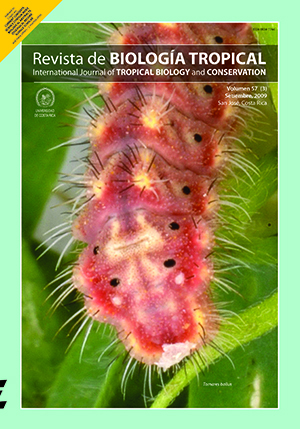Abstract
The study of the feeding ecology of amphibians is an old issue in herpetology. Notwithstanding, the lack of food resources data in many studies of amphibians feeding has lead to partial understanding of frog feeding strategies. In this study we evaluate the trophic selectivity of a red spotted green frog (Hypsiboas punctatus) population from a Middle Paraná River floodplain pond in Argentina, and discuss the importance of prey availability data when interpreting results from diet analysis. We analyzed the gut contents of 47 H. punctatus adults and compared frog's diet with the environmental food resources. Prey availability was estimated by systematically seep-netting the microhabitat where anurans were localized foraging. We identified 33 taxonomic categories from gastrointestinal contents. Numerically, the most important prey categories were dipterans, followed by hemipterans, homopterans and coleopterans. The diet similarity between males and females was high and no statistical differences in diet composition were found. The most abundant food resources in the environment were dipterans, coleopterans, homopterans and collembolans. In order to assess whether frogs were selecting their preys, we calculated Pianka's niche overlap index and Jacobs electivity index comparing gut contents to prey availability data. Trophic niche overlap was medium but significantly higher than expected by chance. The electivity index indicated that H. punctatus foraged dipterans slightly above their environmental abundance. Among the secondary preys, hemipterans were foraged selectively, homopterans were consumed in the same proportion to their occurrence in the environment, coleopterans were foraged quite under their availability and collembolans were practically ignored by frogs. Without food resources data, H. punctatus could be classified as a specialist feeder, but dipterans also were quite abundant in the environment. Our results show that H. punctatus fit better as a generalist feeder, foraging on their main food item and some secondary preys in similar proportion to their environmental availability; even though other secondary preys are being selectively preferred or ignored by frogs. Our data illustrate the importance of including the resource availability data on diet studies to improve the understanding of amphibian feeding ecology.##plugins.facebook.comentarios##

This work is licensed under a Creative Commons Attribution 4.0 International License.
Copyright (c) 2009 Revista de Biología Tropical
Downloads
Download data is not yet available.






